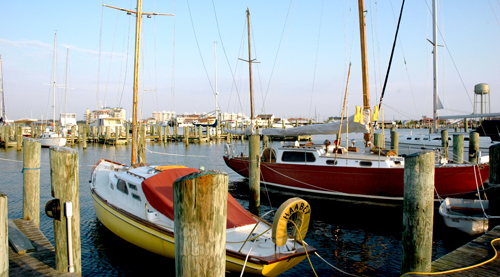
The inhabitants of Crisfield, Maryland, have made their living from the water since the earliest days of Chesapeake Bay commerce. Crabs, oysters, waterfowl and Chesapeake Bay fish are on the menu. Crisfield bills itself as “The Crab Capital of the World” and the town’s water towers proudly display the blue crab in all of its cooked, red-orange glory.
Located on the southern end of Maryland’s Eastern Shore, opposite Virginia’s Northern Neck, the town is known by most outsiders as one of the Delmarva Peninsula’s main jumping off points to the Smith Island and Tangier Island ferries. Tourists by the busload heading to these popular, day-tripper island destinations pass through Crisfield, but independent travelers may find it worthwhile to invest extra time to check out this unique coastal town of nearly 2,700 people.

To glimpse Crisfield’s soul, you really should rise before daybreak -- certainly before most of the traveling world receives its wake-up calls. Gordon’s Confectionery, established in 1924, opens around 4 a.m. and sees a nearly five-hour parade of watermen, commercial fishermen, charter captains and many of their customers. People stop in to grab coffee, maybe something to eat, and yak momentarily about who’s catching what, how the market is faring for crabs or fish, local politics, the price of bait and anything else on their mind.The place still serves (by special order) fountain cokes that could be ordered with spirits of ammonia, supposedly to help cure headaches and other ills. It serves a variety of sandwiches, mostly fried or grilled, at from breakfast until about 8 p.m., depending on patronage.
When I first visited Gordon's almost 20 years ago (it just celebrated its 100th Anniversary) I was introduced to a couple of traditions related to old cigar boxes. Back then, Doug “Cheeseburger” Nelson ran Gordon’s with his partner Kenny Evans, who was then age 82. Kenny’s father was Gordon C. Evans, the store’s founder and namesake. The family used to live above the restaurant. Kenny began working there at age 16.
Kenny got a tiny “spy” camera in the 1960’s and his hobby of snapping candids of unaware patrons led to one of the most unique features of any restaurant in any town: the “Alive” and “Dead” boxes. “After awhile, some of the people in the photos would die, so I starting sorting between those who were still alive and those who’d passed away,” Evans said.
Two El Producto cigar boxes were filled with photographs of customers. Owners and clients would sometimes pull out the boxes and reminisce over friends, “passed” and present.
Anne Bradford of the Somerset County Tourism office, explained, “Those boxes started as a bit of an in-house joke, but it soon became in-house history – the history of this town.”
As I looked through the boxes, 81-year-old Carol Conner was sipping coffee and nibbling a hamburger. He was still working every day for a local poultry farmer. His eyes twinkled as he watched me pick through the old black and white photos in the Alive and Dead Boxes.
“I’m in there – the alive box that is,” he says with a broad smile.
Places like this are local treasures.
At Metompkin Bay Oyster Company, the oyster shucking line often opens before daybreak. Empty shells are deposited into a massive pile outside. Depending on the time of year, live soft-shell crabs are packed tightly into waxed boxes for immediate shipping to customers around the world. While you can’t eat there, you can buy crabs and oysters.

While Gordon's is no frills, nearby The Watermen’s Inn is fine dining. The owners are highly-trained chefs. Ask about the specials. Creativity, presentation and service were superb and the prices very reasonable.
If you want to venture off the main road, back roads such as those leading to the marshy, Jenkins Creek area known as “Down Neck,” are full of opportunities to spy a wide variety of wading and shore birds. Naturalists can check out the Cedar Island Marsh Sanctuary, a 330-acre marsh close to Somers Cover Marina. Guided marsh trips using kayaks are available. The Crisfield Heritage Foundation sponsors the marsh tour programs. The foundation is based in the J. Millard Tawes Historical Museum. Crisfield native Tawes was Maryland’s governor in the late 1950’s, early 1960’s. The museum can be seen in less than an hour and it give an excellent overview of Maryland’s Lower Shore and the town’s history, its commerce and its characters. Crisfield natives Lem and Steve Ward, famed “wildfowl counterfeiters in wood,” carved realistic waterfowl decoys used for hunter’s gunning rigs. The museum bearing their name is actually in Salisbury, but the Crisfield museum has a display of their work, plus the Heritage Foundation is restoring their workshop. The workshop operates on a flex schedule. Call the Crisfield Heritage Foundation to check availability.

North of Crisfield is beautiful Janes Island State Park, part of the Beach to Bay Indian Trail. This 2,900-acre park offers log cabins, campsites, canoeing and kayaking, fishing and crabbing, boat rentals and launch ramps, plus a playground, picnic facilities and a conference center. Campers can bring their own boats and
moor them in a park slip for a nominal fee. Cabins must be reserved in advance. Crisfield also has ghost walks, birding events and a 4th of July Freedom Fest (at the marina). A highlight festival is the Annual J. Millard Tawes Crab & Clam Bake. It’s best to order tickets in advance for that big party. Another big event is the Labor Day Weekend National Hard Crab Derby, which includes the prestigious Governor’s Cup Race (surely right up there with the Kentucky Derby).
For a full rundown on all to see and do in Crisfield and it’s neighbors in Somerset County, Maryland, check out www.visitsomerset.com.

















